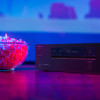Onkyo TX-SR3100 TX -SR Manual - Page 81
Audio
 |
View all Onkyo TX-SR3100 manuals
Add to My Manuals
Save this manual to your list of manuals |
Page 81 highlights
Troubleshooting „ Audio • Make sure that the speaker setup microphone is no longer connected. • Confirm that the connection between the output jack on the connected device and the input jack on this unit is correct. • Make sure that none of the connecting cables are bent, twisted, or damaged. • If "MUTING" is displayed on the display and MUTE is blinking, press MUTE on the remote controller to cancel muting. • While headphones are connected to the PHONES jack, no sound is output from the speakers. • When "Source" - "Audio Select" - "PCM Fixed Mode" on the Setup menu is set to "On", audio is not played if signals other than PCM are input. Change the setting to Off. Check the following if the problem persists after you have confirmed the above. ‰ No sound from the TV • Change the input selector on this unit to the position of the terminal to which the TV is connected. • If the TV doesn't support the ARC function, along with connection by HDMI, connect the TV and this unit using a digital optical cable. ‰ No sound from a connected player ( →p27) • Change the input selector on this unit to the position of the jack to which the player is connected. • Check the digital audio output setting on the connected device. On some game consoles, such as those supporting DVD, the default setting may be off. • For some DVD-Video discs, you need to select an audio output format from a menu. ‰ A speaker produces no sound • Make sure that the polarity (+/-) of the speaker cables is correct, and that no bare wires are in contact with the metal part of speaker terminals. • Make sure that the speaker cables are not shorting out. • Check "Connect the Speaker Cables" ( →p20) to see if the speaker connections have been made correctly. Settings for the speaker connection environment need to be made in "Speaker Setup" in Initial Setup. Check "Initial Setup with Auto Start-up Wizard" ( →p74). • Depending on the input signal and listening mode, not much sound may be output from speakers. Select another listening mode to see if sound is output. ( →p20) 81















